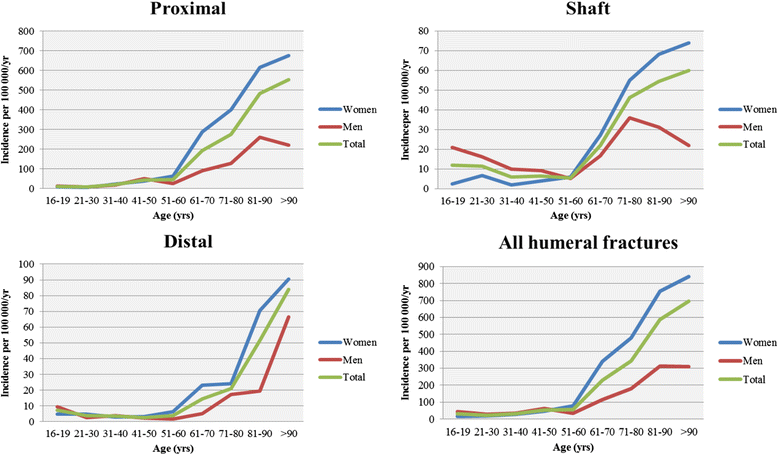Epidemiology and patho-anatomical pattern of 2,011 humeral fractures: data from the Swedish Fracture Register
- PMID: 27072511
- PMCID: PMC4830043
- DOI: 10.1186/s12891-016-1009-8
Epidemiology and patho-anatomical pattern of 2,011 humeral fractures: data from the Swedish Fracture Register
Abstract
Background: Humeral fractures are common, but the association between the patho-anatomical fracture pattern and patient characteristics has been inadequately studied and epidemiological knowledge is scarce. Following the introduction of the Swedish Fracture Register (SFR), risk factors for various fractures can be studied, as well as the outcome of different treatments. The objective of this study was to analyse adult humeral fractures in Gothenburg from a descriptive epidemiological perspective.
Methods: All humeral fractures registered in the SFR at Sahlgrenska University Hospital in 2011-2013 in patients aged ≥ 16 years were included. The fractures were divided into humeral segments (proximal, shaft and distal humerus) and analysed according to patient characteristics and patho-anatomical pattern. Furthermore, overall and age-specific incidence rates were calculated.
Results: A total of 2,011 humeral fractures were registered in the SFR, of which 79% were proximal, 13% shaft and 8% distal humeral fractures. The mean age was 66.8 years and women ran a higher risk of humeral fractures than men (female/male ratio 2.4:1). On average, women were older than men at the time of fracture (mean age 70.1 years for women vs. 58.9 years for men). The overall incidence of humeral fractures was 104.7 per 100,000 inhabitants per year, with a segment-specific incidence of 83.0 for proximal fractures, 13.4 for shaft fractures and 8.3 per 100,000 person-years for distal fractures. There was a distinct increase in the age-specific incidence from the fifth decade and onwards, regardless of fracture site. Most fractures occurred in older patients (83% > 50 years) as a result of a simple or an unspecified fall (79% > 50 years). Only 1.2% of all fractures were open injuries and 1.3% were pathological.
Conclusion: This population-based study provides updated epidemiological data on humeral fractures in a Western-European setting. Most humeral fractures occur as the result of low-energy falls in the elderly population, indicating the influence of age-related risk factors in these fractures. The SFR will be a useful tool for providing continuous information on fracture epidemiology, risk factors and treatment outcome and these population-based data are essential in the planning of future fracture prevention and management.
Keywords: AO/OTA classification; Fracture register; Incidence; Population-based epidemiology; Proximal, shaft and distal humeral fracture.
Figures




References
Publication types
MeSH terms
LinkOut - more resources
Full Text Sources
Other Literature Sources
Medical
Miscellaneous

